Grumman HU-16 Albatross Videos
|
Loading...
|
|
Grumman HU-16 Albatross
HU-16 Albatross
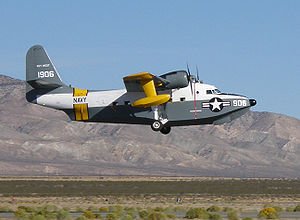
Picture - Restored Navy UF-1/HU-16C BuNo 131906, built June 1953
Role: Flying boat
Manufacturer: Grumman
First flight: 1949
Introduced: 1949
Primary users: United States Air Force
United States Coast Guard
United States Navy
Produced: 1949-1961
Number built: 466
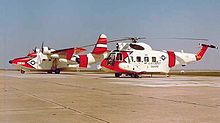
Picture - U.S. Coast Guard Grumman HU-16E Albatross and a Sikorsky HH-52A Seaguard in March 1964, probably at CGAS Mobile, AL
The Grumman HU-16 Albatross is a large twin-radial engine amphibious flying boat. Originally designated SA-16, it was renamed HU-16 in 1962.
Design and development
An improvement of the design of the Grumman Mallard, the Albatross was developed to land in open ocean situations to rescue downed pilots. Its deep-V cross-section and substantial length enable it to land in the open sea. The Albatross was designed for optimal 4 ft seas, and could land in more severe conditions, but required JATO for takeoff in 8-10 ft seas or greater.
Since the aircraft weighs over 12,500 pounds, pilots of US-registered Albatross aircraft must have a type rating. There is a yearly Albatross fly-in at Boulder City, Nevada where Albatross pilots can become type rated.
Operational history
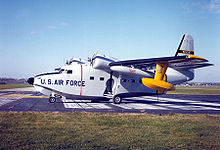
Picture - Air Force HU-16B
The majority of Albatrosses were used by the U.S. Air Force, primarily by the Air Rescue Service, and initially designated as SA-16. The USAF utilized the SA-16 extensively in Korea for combat rescue, where it gained a reputation as a rugged and seaworthy craft. Later, the redesignated HU-16B (long-wing variant) Albatross was used by the U.S. Air Force's Aerospace Rescue and Recovery Service and saw extensive combat service during the Vietnam conflict. In addition a small number of Air National Guard Air Commando Groups were equipped with HU-16s for covert infiltration and extraction of special forces from 1956 to 1971.
The U.S. Navy also employed the HU-16D Albatross as a Search and rescue (SAR) aircraft from coastal naval air stations, both stateside and overseas. It was also employed as an operational support aircraft worldwide and for "skunk runs" from the former NAS Agana, Guam during the Vietnam War. Goodwill flights were also common to the surrounding Trust Territory of the Pacific Islands in the early 1970s. Open water landings and water takeoff training using JATO was also conducted frequently by U.S. Navy HU-16s from locations such as NAS Agana, Guam; Naval Station Guantanamo Bay, Cuba; NAS Barbers Point, Hawaii; and NAS Pensacola, Florida, among other locations.
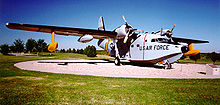
Picture - HU-16E on static display at Dyess AFB, TX
The HU-16 was also operated by the U.S. Coast Guard as both a coastal and long-range open ocean SAR aircraft for many years until it was supplanted by the HU-25 Guardian and HC-130 Hercules. The final Navy HU-16 flight was made 13 August 1976 when an Albatross was delivered to the Naval Aviation Museum at NAS Pensacola.
Civil operations
In the mid-1960s the U.S. Department of the Interior bailed 3 military Grumman HU-16's from the U.S. Navy and established the Trust Territory Airlines in the Pacific to serve the islands of Micronesia. Pan American World Airways and finally Continental Airlines' Air Micronesia operated the Albatrosses serving Yap, Palau, Chuuk (Truk) and Pohnpei from Guam until 1970, when adequate island runways were built, allowing land operations.
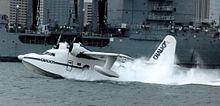
Picture - Chalk's International Airlines Albatross arriving in Miami Harbor from Nassau, Bahamas, in 1987
In 1970, Conroy Aircraft marketed a remanufactured HU-16A with Rolls-Royce Dart turboprop engines as the Conroy Turbo Albatross, but only the single prototype (registration N16CA) was ever built.
Many surplus Albatrosses were sold to civilian operators, mostly to private owners. These aircraft are operated under either Experimental - Exhibition or Restricted category and cannot be used for commercial operations, except under very limited conditions.
In the early 1980's Chalk's International Airlines owned by Merv Griffin's Resorts International had 13 Albatrosses converted to Standard category as G-111's. This made them eligible to be used in scheduled airline operations. These aircraft had extensive modification from the standard military configuration, including rebuilt wings with titanium wing spar caps, additional doors and modifications to existing doors and hatches, stainless steel engine oil tanks, dual engine fire extinguishing systems on each engine and propeller auto feather systems installed. The G-111's were only operated for a few years and then put in storage in Arizona. Most are still parked there, but some have been returned to regular flight operations with private operators.
In March 2009 ABC News reported that an Albatross flown for the energy drink maker "Red Bull" had been grounded at least twice and had been the subject of an FAA safety investigation concerning its safe flight.
The pilot/operator of the "Red Bull" Albatross airplane later went on to operate and fly the Grumman Mallard used in the 2010 movie The Expendables featuring Sylvester Stallone.
Accidents and incidents
On 5 November 2009, Albatross N120FB of Albatross Adventures crashed shortly after take-off from St. Lucie County International Airport, Fort Pierce, Florida. An engine failed shortly after take-off, the aircraft was damaged beyond economic repair.
Variants
XJR2F-1 - Prototype designation, two built.
HU-16A (originally SA-16A) - USAF version
HU-16A (originally UF-1) - Indonesian version
HU-16B (originally SA-16A) - USAF version (modified with long wing)
SHU-16B (modified HU-16B for Anti-Submarine Warfare) - export version
HU-16C (originally UF-1) - US Navy version
LU-16C (originally UF-1L) - US Navy version
TU-16C (originally UF-1T) - US Navy version
HU-16D (originally UF-1) - US Navy version (modified with long wing)
HU-16D (originally UF-2) - German version (built with long wing)
HU-16E (originally UF-1G) - US Coast Guard version (modified with long wing)
HU-16E (originally SA-16A) - USAF version (modified with long wing)
G-111 (originally SA-16A) - derived from USAF, JASDF, and German originals)
CSR-110 - RCAF version
Operators
Argentina Brazil Canada Chile Republic of China Colombia
Colombian Air Force
Germany
German Navy
Greece
Hellenic Air Force
Iceland
Icelandic Coast Guard
Indonesia Italy Japan Malaysia Mexico Norway
Royal Norwegian Air Force
Pakistan
Pakistan Air Force
Pakistan Navy - Pakistan Naval Air Arm
Peru Philippines
Philippine Air Force
Philippine Navy
Portugal Spain Thailand
Royal Thai Navy
United States
United States Air Force
United States Coast Guard
United States Navy
Venezuela
Survivors
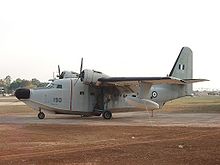
Picture - Preserved Hellenic AF aircraft at Dekelia AB.
HU-16B, AF Serial No. 51-5282, at the National Museum of the United States Air Force, Wright-Patterson AFB, Ohio. This was USAF's last operational HU-16. On 4 July 1973 it established a world record for twin-engine amphibians when it reached 32,883 feet. Two weeks later it was flown to the Air Force Museum.
HU-16B, AF Serial No. 51-7176, was at the Pate Museum of Transportation in Cresson, Texas. It is being disassembled and moved to Coast Guard Air Station Clearwater in Clearwater, Florida where it is to be restored.
HU-16E, AF Serial No. 51-7251, at Dyess Linear Air Park, Dyess AFB, Texas
HU-16C, US Navy Albatross displaying NAS Alameda and designation number 1911, assigned to USS Carl Vinson. Currently located on the north end of the field at Charles M. Schulz - Sonoma County Airport in reportably flyable condition.
Jimmy Buffett's Hemisphere Dancer, now the centerpiece of Universal Studios' Margaritaville Cafe in Orlando, Florida.
Restored US Navy UF-1/HU-16C, Navy Bureau Number (BuNo) 131906, originally built June 1953
Swimwear manufacturer Billabong operates a well-equipped Albatross for surf touring.
Quiksilver also operates a similarly-equipped Albatross for surf touring.
Several private owners have Albatrosses equipped with sleeping quarters which can be used as an airborne recreational vehicle (sleep-aboard), either at an airport or on the water.
HU-16B Albatross, AF Serial No. 51-7163, at Castle Air Museum adjacent to the (former Castle AFB, Atwater, California
Two HU-16Bs of the Hellenic Air Force are on display at Dekelia (Tatoi) Air Base, north of Athens.
HU-16E of the United States Navy (BuNo 141266) and an HU-16E of the U.S. Coast Guard (USCG 7236) at the National Museum of Naval Aviation at NAS Pensacola, Florida. These aircraft were the last operational HU-16s in their respective services.
HU-16A, AF Serial No. 51-0022 at the Pima Air and Space Museum in Tucson, Arizona.
HU-16E, USCG 7250, at CGAS Cape Cod at Otis Air National Guard Base, Massachusetts.
HU-16E, USCG 1293, March Field Air Museum, March ARB, California
HU-16B, AF Serial No. 51-1280, adjacent to the 58th Special Operations Wing compound at Kirtland AFB, New Mexico.
HU-16E, USCG 7247, at CGAS Elizabeth City, North Carolina.
HU-16B, N44HQ, owned and operated by Row 44 and equipped with in-flight WiFi as a test and marketing tool.
SHU-16B, in Chilean Air Force colors as part of the static exhibition at the Museo Aeronx¡utico in Santiago de Chile
HU-16B at Warfield Air National Guard Base, in Baltimore, Maryland.
HU-16 of the Republic of China Air Force at Chung Cheng Aviation Museum, Taipei, Taiwan
Specifications (HU-16B)
Data from Albatross - Amphibious Airborne Angel
General characteristics
Crew: 4-6
Capacity: 10 passengers
Length: 62 ft 10 in (19.16 m)
Wingspan: 96 ft 8 in (29.47 m)
Height: 25 ft 10 in (7.88 m)
Wing area: 1035 ft² (96.2 m²)
Empty weight: 22,883 lb (10,401 kg)
Loaded weight: 30,353 lb (13,797 kg)
Max takeoff weight: 37,500 lb (17,045 kg)
Powerplant: 2x— Wright R-1820-76 Cyclone 9 nine-cylinder single-row air-cooled radial engine, 1,425 hp (1,063 kW) each
Fuel Capacity: 675 US Gallons (2,550 L) internally, plus 400 US Gal (1,512 L) in wingtip floats plus two 300 US Gallon (1,135 L) drop tanks
Performance
Maximum speed: 205 knots (236 mph, 380 km/h)
Cruise speed: 108 knots (124 mph, 200 km/h)
Stall speed: 64 knots (74 mph, 119 km/h)
Range: 2,478 nmi (2,850 mi, 4,589 km)
Service ceiling: 21,500 ft (6,550 m)
Rate of climb: 1,450 ft/min (7.4 m/s)
Armament
None
Notable appearances in media
Related development
Grumman Goose
Grumman Mallard
Comparable aircraft
Canadair CL-215
PBY Catalina
Dorr, Robert F. "Albatross - Amphibious Airborne Angel". Air International, October 1991, Vol. 41, No. 4. ISSN 0306-5634. pp. 193-201.
Swanborough, Gordon and Peter M. Bowers. United States Navy Aircraft since 1911. London:Putnam, Second edition, 1976. ISBN 0 370 10054 9.
Production listing, source for Variants section
Flight test report http://www.eaa1000.av.org/fltrpts/albatross/albatross.htm
Grumman HU-16 Albatross Pictures and Grumman HU-16 Albatross for Sale.
Living Warbirds: The best warbirds DVD series.
Source: WikiPedia